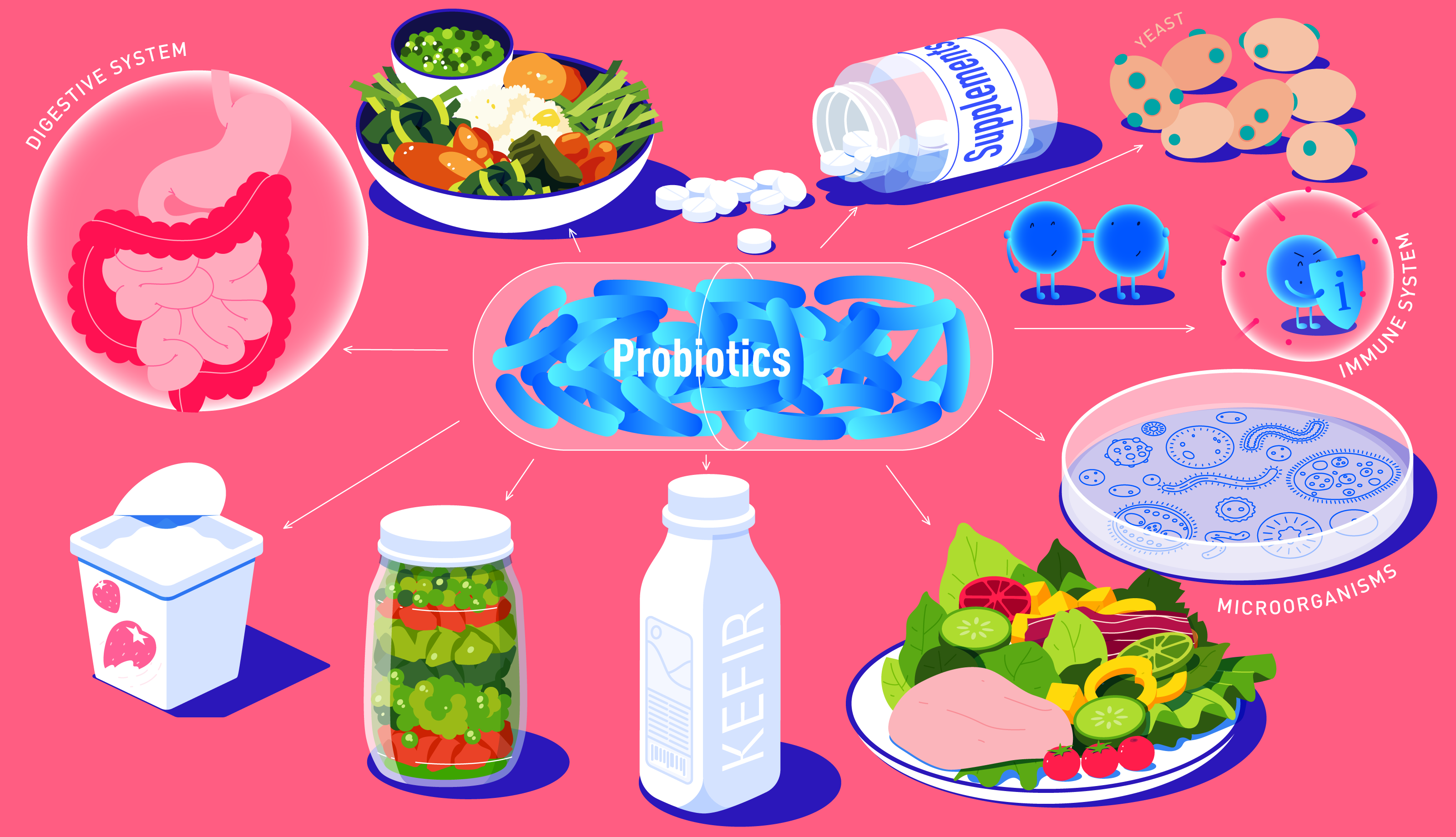Find out the difference between pathobionts, pathogens, probiotics and commensal bacteria, including how they influence health for better or worse.
- Commensal bacteria
- Opportunistic pathogens & pathobionts
- Dysbiosis: chaos is a ladder
- Does pathogenicity exist on a spectrum?
- Probiotic bacteria
- Article summary
The human body is populated by trillions of microbes, comprising eukaryotes, protozoa, fungi, viruses and most abundant of all, bacterium.
Over millions of years, we have co-evolved with these microscopic neighbours to live in symbiosis, much like sharks co-exist with the little fish that clean their underbelly; we scratch their back, and they scratch ours.
Bacterial genes dwarf your native human genome and dialogue with your human cells, influencing your immune, metabolic and intestinal health.
Without further ado, let’s survey the cast of characters in your gut and their respective functions, including commensal, pathogenic, pathobiont and probiotic bacteria.
☝DID YOU KNOW?☝ Microbial genes outnumber our own by a factor of 100 to 1
Commensal bacteria
The largest and most important community of microbes inhabit the large intestine, collectively known as our commensal microbiota.
Whilst the microbiome hosts a diverse cast of microbes, we will focus primarily on bacteria, as these are the best studied.
Whilst “good bacteria” often refers to probiotics (more on them later), your commensal gut bugs are also beneficial to health (most of the time, that is).
In return for a space to live and nutrients to munch on, your commensal gut bugs perform various crucial health functions, acting as an “organ” in the human body.
Among their many beneficial functions, commensal bacteria protect against pathogens (something called colonisation resistance), metabolise indigestible fibres, maintain the health of the gut lining and train immune cells to function properly, as we shall explore below:
Colonisation resistance
At the very least, commensal bacteria compete with opportunistic pathogens in the gut for space and nutrients, preventing them from gaining a foothold. Commensal bacteria use a variety of methods to fend off enteric pathogens, including:
- Generate inhibitory substances to undermine pathogenic growth
- Eat the competitions food source, therefore starving pathogens
- Reinforce the intestinal wall, minimising inflammation
Commensal microbes have a few weapons at their disposal to directly inhibit and challenge pathogens.
Firstly, certain bacteria can metabolise butyrate, a short-chain fatty acid that downregulates “virulence” genes in pathogens, undermining their ability to infect the host.
Continuing, other commensals produce antimicrobial peptides called bacteriocins, inhibiting the growth of invading pathogens.
These are targetted compounds which selectively kill microbial competition. For example, Bacteroides thuringiensis produces a bacteriocin called thuricin CD, which directly targets the pathogen Clostridium difficile (more on later).
Lastly, commensal bacteria create antimicrobial substances from bile acids generated in the liver. Tellingly, a depletion in bacteria that metabolise secondary bile acids places someone at increased risk for Clostridium difficile colonisation.
The more diverse the community of commensal bacteria, the better, as this makes the system more resilient to disruptions such as stress or antibiotics.
Break down indigestible fibres and metabolise Short Chain Fatty Acids (SCFAs)
Commensal bacteria utilise their many genes to perform jobs our human cells cannot, such as digesting resistant fibres. In turn, this gives us access to more nutrients we couldn’t otherwise access.
Moreover, some commensal microbes belch out short-chain fatty acids after fermenting fibre, including acetate, propionate and butyrate.
The benefits of SCFAs are well documented, particularly butyrate; this anti-inflammatory compound fuels cells in the gut lining, reinforcing the intestinal wall and minimising inflammation. Well-known butyrate-producing bacteria include:
- Faecalibacterium prausnitzii
- Clostridium leptum
- Eubacterium rectale
- Roseburia spp.
☝FUN FACT☝ With the Atlas Microbiome Test, you’ll discover how many butyrate-producing species you have compared to the population
Train and regulate the immune system
Your body is colonised by a flood of microbes as soon as you are born. Depending on how you are born (vaginally or surgically) and reared (bottle-fed or breast-fed), the colony of microbes in your gut will look different.
Tellingly, mice raised without commensal gut microbes possess underdeveloped immune defences, including smaller Peyer’s patches and fewer antimicrobial peptides. As a result, germ-free mice experience more severe disease states than their colonised counterparts.
Interestingly, children born via c-section or bottle-fed experience allergies and autoimmune disorders at a higher rate, suggesting these early factors hinder immune education by disrupting microbiome diversity.
☝DID YOU KNOW?☝ Children raised in close proximity to animals experience lower rates of allergies in later life.
Opportunistic pathogens
So we’ve established the role of commensal bacteria, which comprise the lion’s share of your microbiome. But as it turns out, some of your commensal “symbionts” can do harm, given the right situation.
Opportunistic pathogens are bacteria with the potential to cause disease under specific circumstances, such as in those who are immunocompromised. When they originate from within the gut, as opposed to outside, they are also called “pathobionts”.
In healthy individuals, opportunistic pathogens generally exist without ill effect, although environmental changes to the gut ecosystem may make them “break bad”.
In other cases, opportunistic pathogens may cause mild illness in healthy individuals but severe illness in those whose microbiome is disturbed.
A good example of an opportunistic pathogen is Clostridium difficile, a bacterial species which can cause severe infection and chronic diarrhoea.
In healthy individuals, small amounts of c.diff can exist harmlessly in the microbiome, largely due to the protective effect of commensal bacteria. However, disruptions to microbiome diversity can allow overgrowth of c.diff, triggering infection.
The predominant cause of c.diff infection is antibiotics, which can cause collateral damage to commensal bacteria in the biome.
Likewise, Helicobacter hepaticus has been implicated with large bowel disease in mice, but only in immunocompromised rodents. In wild, healthy mice, H. hepaticus causes no adverse effects.
Dysbiosis: chaos is a ladder

Dysbiosis refers to a microbiome profile low in diversity and enriched in inflammatory species.
Whilst the specifics differ, these markers are associated with multiple diseases, including obesity, inflammatory bowel disease and depression. However, it remains unclear whether dysbiosis is a cause or consequence of these disease states.
A dysbiotic microbiome can reduce a person’s colonisation resistance to pathogens, making them vulnerable to infection; the less commensals in the gut, the less resistance pathogens encounter.
Multiple factors can shift microbiome composition towards dysbiosis, including:
- antibiotics
- poor diet
- stress
- immunotherapy
Whilst dysbiosis can accomodate pathogenic overgrowth, enteric pathogens have a few tricks to undermine commensal bacteria and promote their growth as well.
Firstly, they can directly attack/inhibit commensal bacteria via their metabolites, just as commensals wage war on them.
In addition, pathogens can weaken our community of commensals by inducing inflammation, much like an invading army might launch a bombing campaign before sending in the landing craft.
An inflammatory environment can encourage opportunistic pathogens to adapt in ways detrimental to the host. In turn, this fuels inflammation and creates a vicious cycle.
☝DID YOU KNOW?☝ With an Atlas Microbiome Test, we’ll calculate your risk score for five microbiome-related diseases, including ulcerative colitis and Crohn’s. To do this, we compare your microbiome composition to those with the disorder; the greater the similarities, the higher your risk score
Does pathogenicity exist on a spectrum?

The label “opportunistic pathogen” or “pathobiont” has come under attack for being vague and unhelpful. As an opinion piece in the journal Cell notes:
“By now, the term “pathobiont” serves to describe multiple, different phenomena that hardly comprise a well-defined concept”.
The authors argue that hastily categorising species as “pathobionts” without fully understanding their mechanisms can prevent scientists from searching for potentially beneficial roles in these species.
For example, some species associated with disease in western microbiomes are found in high proportions among people living more “ancestral” lifestyles. Take the Hadza people, one of the last hunter-gather tribes in existence.
Upon auditing their microbiomes, scientists discovered that they possess high levels of certain treponema species, typically associated with disease states.
The Hadza people boast low disease rates, suggesting that in the right circumstances, certain treponema species may be beneficial to health.
Although it’s rare, there are reported cases of bifidobacterium longum, a proven probiotic that supports the immune system, causing infection in immunocompromised patients.
In light of this, the researchers posit that it could qualify as a “pathobiont”, despite also being a probiotic, blurring the lines between the two terms.
Other beneficial microbes may also become pathogenic in response to biological changes, such as age. For example, Akkermansia Municiphilia strengthens the gut lining by feeding on its protective mucus layer, stimulating new growth.
Tellingly, Akkermansia is associated with inflammation in older subjects, suggesting it ceases to stimulate new growth and accelerates deterioration in old age, undermining the intestinal walls’ defences.
In light of this, the opinion piece suggests moving away from black and white labels (pathogenic/commensal) and assigning bacteria a Pathogenic Potential (PP) score, reflecting that pathogenicity exists on a spectrum.
Probiotics: reinforcements for your commensal bacteria

Just as microbes from outside the body can enter and cause trouble (exogenous pathogens), bacterial strains can also be sent in to help your commensals.
Probiotics are live microorganisms that confer health benefits when administered in sufficient amounts. They can be obtained from fermented foods like sauerkraut & kimchi or probiotic supplements.
Probiotics can support the commensal bacteria living in the gut,particularly when they are challenged by things such as antibiotics or microbes abroad (travellers diarrhoea). Think of them like a crack-team of soldiers parachuted to the gut to relieve troops under fire.
Probiotic strains rarely set up permanent colonies in the gut, but they can interact with our commensal microbes on their way through the GI tract.
Probiotics confer health benefits by the same mechanisms as your commensal bacteria. For example, they can regulate the immune system, compete against pathogens for space and metabolise indigestible fibres.
Probiotics can also be taken with prebiotics, which are indigestible fibres that feed beneficial bacteria. When taken together, they are known as synbiotics.
Article summary
- You play host to trillions of commensal microbes in your gut, outnumbering your human genes and equalling your number of cells. In return for space and nutrients, these microscopic residents act as an “organ”, offering crucial health functions.
- Commensal bacteria protect against pathogens, metabolise indigestible fibres, maintain the health of the gut lining and train immune cells to function properly.
- Some commensal bacteria can become pathogenic in certain circumstances, which researchers refer to as “opportunistic pathogens” or “pathobionts”.
- For example, Clostridium difficile can exist without harm in a healthy microbiome, but microbial perturbations related to antibiotics can allow the bacteria to cause infection.
- Pathogens can also enter the body from outside, which is known as exogenous bacteria. A dysbiotic microbiome can increase a person’s vulnerability to both internal and external infection.
- Some have argued that the term pathobiont is unhelpful, oversimplifying pathogenicity in bacteria. Instead, they suggest using a Pathogenic Potential (PP) scale, placing bacteria on a spectrum.
- Probiotics are live organisms that can support our commensal bacteria, particularly when challenged by things such as antibiotics or travelling-related pathogens.

☝️DISCLAIMER☝This article is for informational purposes only. It is not intended to constitute or be a substitute for professional medical advice, diagnosis, or treatment.




















